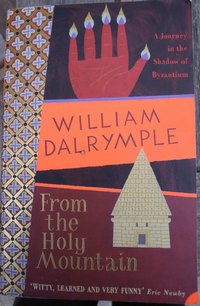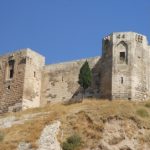“A culturally barren and financially impoverished mono-ethnic megalopolis.” Recognise that description? Well, believe it or not that is how William Dalrymple described Istanbul, the happening city of the moment, in his magisterial From the Holy Mountain. But of course he carried out the research for the book in the mid-1990s and his description acts as a sobering reminder of just how far and how fast change has swept over Turkey.
Dalrymple is one of the greatest of modern British travel writers, combining a rare ability to home in on the esoteric – in this case the journeying of the 6th-century Byzantine monk John Moschos as described in his book The Spiritual Meadow – with a pitch-perfect ear for dialogue. These are brought together wonderfully in this classic travelogue which describes how he followed in Moschos’ footsteps all the way from Mt Athos In Greece, down through the Middle East to the Great Kharga Oasis in Egypt. On the way he reords the sad plight of the declining Christian populations in almost all these countries; only in Syria does he detect any hope for their future in an area that he reminds us was once the heartland of Christianity.
Like all great travel writers, Dalrymple homes straight in on the places that the rest of us tend to miss. Of course he dropped in on the Greek Orthodox Patriachate in Fener and the Armenian Patriarchate in Kumkapı which will probably be familiar to readers. Less familiar, however, will be the church of St Polyeuctes, the shattered remains of which stand unloved in Fatih, just a short walk away from the offices of the Istanbul Municipality. This, Dalrymple tells us, was once the greatest church in Constantinople and the Emperor Justinian may have been trying to outdo it in splendour when he commissioned Hagia Sophia. It was, at one time, just one of around 500 churches in the city. Of them, less than 30 are still standing, most of them converted into mosques.
“A sleepy provincial place” – this is how Dalrymple describes the Antakya (Antioch) of the mid-1990s which is not, of course, how it would probably strike most visitors today who can take their pick from a growing number of snazzy hotels and restaurants, some of them designed to entice new holiday-making custom from Syria. He was there to visit the remains of the monastery of St Symeon the Stylite, one of that strange breed of men, the Byzantine equivalent perhaps of modern Hindu sadhus, who thought that the quickest route to heaven was to spend their lives sitting on top of pillars. In Moschos’ day, he tells us, all the surrounding peaks were crowned with pillars on which lived assorted stylites in fierce competition with one another for followers. But here Dalrymple had the better of modern visitors. When he visited the site of this once rich and famous monastery he had it to himself. Modern visitor, however, may find their enjoyment of the site ruined by noisy tourists and the sight of crude graffiti disfiguring the walls.
Today Şanlıurfa (Urfa), the ancient Edessa, is a holy city for Muslims, the destination of pilgrims from all over the Middle East who come here to visit the cave in which the Prophet Abraham is believed to have been born. This being the case Urfa is a conservative and overwhelmingly Muslim town and it comes as quite surprise to be reminded by Dalrymple that it was once just as overwhelmingly Christian, albeit awash with people whose believers would come to be deemed heretical. Later he comes across a church in Aleppo where the last descendants of Christian Urfalıs expelled from the city in 1924 have made their base, a wholly unexpected twist to the tale.
As far as Urfa Dalrymple was following a trail taken by many contemporary tourists. But then he diverted to visit the Tur Abdin, the heartland of Syrian Orthodoxy around Midyat. In the mid-1990s this was a sorely troubled area where travel was constrained by curfews, police checks and outright road closures as well as by fear of PKK and Hezbollah terrorists. Even his visit to the monastery of Deir el-Zaferan, today a full-on tourist attraction with a visitor centre part-funded by the EU, was an adventure carried out with the police in hot pursuit and getting to Mor Gabriel (oddly called Mar Gabriel here) involved a race against the curfew hour.
All this would have been tough enough for most travellers but Dalrymple also headed out to the village of Ein Wardo where, during the First World War, an episode took place that has got lost amid the welter of publicity over the Armenians. Fearing what might happen to them, the Suryanis from the surrounding villages armed themselves and gathered in Ein Wardo, turning it into a fortified stronghold with the church as its centrepiece. There they were besieged by the Ottoman army and Kurdish irregulars and almost starved into submission. Finally, the siege was lifted but even today you can still see the marks of bulletholes in the church walls.
Dalrymple’s journey takes him on through the Middle East to Egypt, meeting yet more beleaguered Christian communities along the way. Ultimately he decides that there is least hope for those in Turkey and Palestine, giving them perhaps another 20 years of existence at most. It’s a thought to ponder when visiting the modern Tur Abdin where the Midyat authorities are hard at work promoting the idea of multiculturalism despite considerable evidence on the ground that not a lot has really changed.
William Dalrymple, 1997
Review written: 5 August 2011


